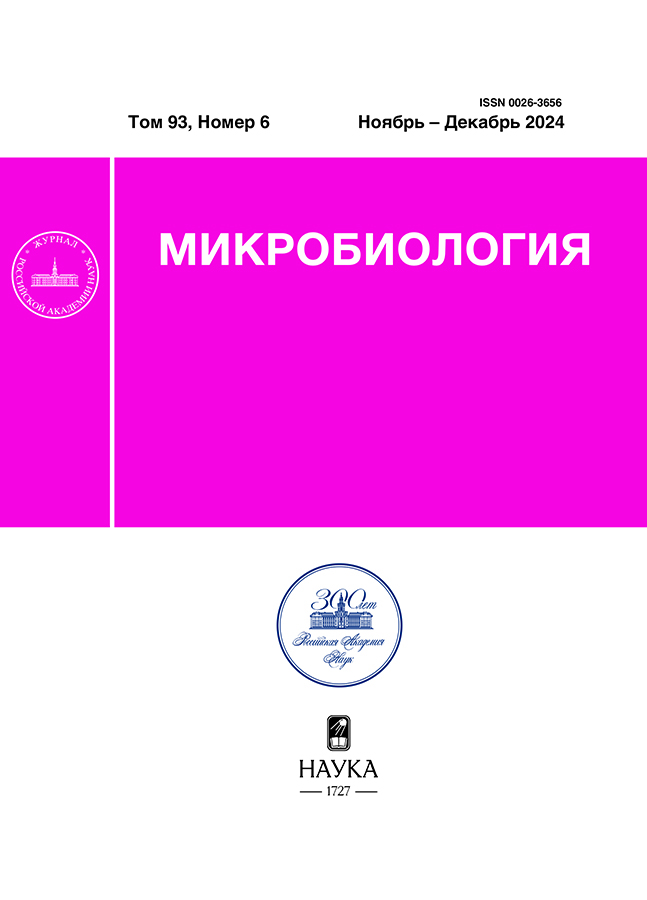Expression of heterologous PEP-carboxylase in Methylococcus capsulatus MIR: the influence on growth characteristics and amino acid composition of methanotrophic biomass
- Authors: But S.Y.1,2, Rozova O.N.1,2, Chistyakova S.V.2, Potapova D.S.3, Khmelenina V.N.2, Mustakhimov I.I.1,2
-
Affiliations:
- Research Center of Biotechnology, Russian Academy of Sciences
- Pushchino Scientific Center for Biological Research, Russian Academy of Sciences
- Tula State University
- Issue: Vol 93, No 6 (2024)
- Pages: 879-883
- Section: SHORT COMMUNICATIONS
- URL: https://snv63.ru/0026-3656/article/view/655068
- DOI: https://doi.org/10.31857/S0026365624060173
- ID: 655068
Cite item
Abstract
Methylococcus capsulatus MIR is a strain of methanotrophic bacteria that is potentially suitable for producing feed protein and other value-added products from methane. Genomic analysis did not reveal in Mc. capsulatus MIR known pathways of C3-carboxylation, necessary for the replenishment of intermediates of the tricarboxylic acid cycle and the full functioning of metabolism. The pepc gene encoding PEP carboxylase in Methylomonas rapida 12 was introduced into Mc. capsulatus MIR cells on a plasmid under the control of a medium-strength promoter. Expression of heterologous PEP carboxylase led to an increase in the content of glutamate, glycine and lysine in the cells of the recombinant strain, but did not increase to the growth rate of the culture. Consequently, the introduction of heterologous PEP carboxylase, which carries out the C3-carboxylation reaction, helps to increase the nutritional value of the methanotroph biomass.
Full Text
About the authors
S. Y. But
Research Center of Biotechnology, Russian Academy of Sciences; Pushchino Scientific Center for Biological Research, Russian Academy of Sciences
Author for correspondence.
Email: sergeybut20063@gmail.com
Winogradsky Institute of Microbiology; Institute of Biochemistry and Physiology of Microorganisms
Russian Federation, Moscow, 119071; Moscow region, Pushchino, 142290O. N. Rozova
Research Center of Biotechnology, Russian Academy of Sciences; Pushchino Scientific Center for Biological Research, Russian Academy of Sciences
Email: sergeybut20063@gmail.com
Winogradsky Institute of Microbiology; Institute of Biochemistry and Physiology of Microorganisms
Russian Federation, Moscow, 119071; Moscow region, Pushchino, 142290S. V. Chistyakova
Pushchino Scientific Center for Biological Research, Russian Academy of Sciences
Email: sergeybut20063@gmail.com
Institute of Biochemistry and Physiology of Microorganisms
Russian Federation, Moscow region, Pushchino, 142290D. S. Potapova
Tula State University
Email: sergeybut20063@gmail.com
Russian Federation, Tula, 300012
V. N. Khmelenina
Pushchino Scientific Center for Biological Research, Russian Academy of Sciences
Email: sergeybut20063@gmail.com
Institute of Biochemistry and Physiology of Microorganisms
Russian Federation, Moscow region, Pushchino, 142290I. I. Mustakhimov
Research Center of Biotechnology, Russian Academy of Sciences; Pushchino Scientific Center for Biological Research, Russian Academy of Sciences
Email: sergeybut20063@gmail.com
Winogradsky Institute of Microbiology; Institute of Biochemistry and Physiology of Microorganisms
Russian Federation, Moscow, 119071; Moscow region, Pushchino, 142290References
- Розова О. Н., Хмеленина В. Н., Мустахимов И. И., Бут С. Ю., Троценко Ю. А. Свойства рекомбинантного малик-фермента у аэробного метанотрофа Methylosinus trichosporium // Биохимия. 2019. T. 84. C. 532–539.
- Rozova O. N., Khmelenina V. N., Mustakhimov I. I., But S. Yu., Trotsenko Yu.A . Properties of malic enzyme from the aerobic methanotroph Methylosinus trichosporium // Biochemistry (Moscow). 2019. V. 84. Р. 390‒397.
- Хмеленина В. Н., Бесчастный А. П., Гаязов А. П., Троценко Ю. А. . Влияние пирофосфата на рост и метаболизм Methylomonas methanica // Микробиология. 1994. Т. 63. С. 188–193.
- B uch A., Archana G., Naresh Kumar G. Heterologous expression of phosphoenolpyruvate carboxylase enhances the phosphate solubilizing ability of fluorescent pseudomonads by altering the glucose catabolism to improve biomass yield // Bioresour Technol. 2010. V. 101. P. 679–687.
- But S. Y., Egorova S. V., Khmelenina V. N., Mustakhimov I. I. Malyl-CoA lyase provides glycine/glyoxylate synthesis in type I methanotroph // FEMS Microbiol. Lett. 2020. V. 367. Art. fnaa207.
- But S. Y., Egorova S. V., Khmelenina V. N., Trotsenko Y. A. Serine-glyoxylate aminotranferases from methanotrophs using different C1-assimilation pathways // Antonie van Leeuwenhoek. 2019. V. 112. P. 741–751.
- Hanson R., Hanson T. Methanotrophic bacteria // Microbiol. Rev. 1996. V. 60. P. 439–471.
- Henard C. A., Smith H., Dowe N., Kalyuzhnaya M. G., Pienkos P. T., Guarnieri M. T. Bioconversion of methane to lactate by an obligate methanotrophic bacterium // Sci. Rep. 2016. V. 6. Art. 21585.
- Koffas M. A.G., Jung G. Y., Stephanopoulos G. Engineering metabolism and product formation in Corynebacterium glutamicum by coordinated gene overexpression // Metab. Eng. 2003. V. 5. P. 32–41.
- Oshkin I. Y., Danilova O. V., But S. Y., Miroshnikov K. K., Suleimanov R. Z., Belova S. E., Tikhonova E. N., Kuznetsov N. N., Khmelenina V. N., Pimenov N. V., Dedysh S. N. Expanding characterized diversity and the pool of complete genome sequences of Methylococcus species, the bacteria of high environmental and biotechnological relevance // Front. Microbiol. 2021. V. 12. Art. 756830.
- Oshkin I. Y., Suleimanov R. Z., Khmelenina V. N., Mardanov A. V., Pimenov N. V. , Dedysh S. N. Complete genome sequence of Methylococcus capsulatus MIR, a methanotroph capable of growth on methanol // Microbiol. Resour. Announc. 2022. V. 11. Art. e0054222.
- Rumah B. L., Claxton Stevens B. H., Yeboah J. E., Stead C. E., Harding E. L., Minton N. P., Zhang Y. In vivo genome editing in type I and II methanotrophs using a CRISPR/Cas9 system // ACS Synth. Biol. 2023. V. 12. P. 544–554.
- Schaefer H., Mikaloff Fletcher S. E., Veidt C., Lassey K. R., Brailsford G. W., Bromley T. M., Dlugokencky E. J., Michel S. E., Miller J. B., Levin I., Lowe D. C., Martin R. J. , Vaughn B. H., White J. W.C. A 21 st -century shift from fossil-fuel to biogenic methane emissions indicated by 13 CH 4 // Science. 2016. V. 352. P. 80–84.
- Strong P. J., Kalyuzhnaya M., Silverman J., Clarke W. P. A methanotroph-based biorefinery: potential scenarios for generating multiple products from a single fermentation // Bioresour. Technol. 2016. V. 215. P. 314–323.
- Tollefson J . Scientists raise alarm over “dangerously fast” growth in atmospheric methane // Nature. 2022. https://doi.org/10.1038/d41586-022-00312-2
Supplementary files












